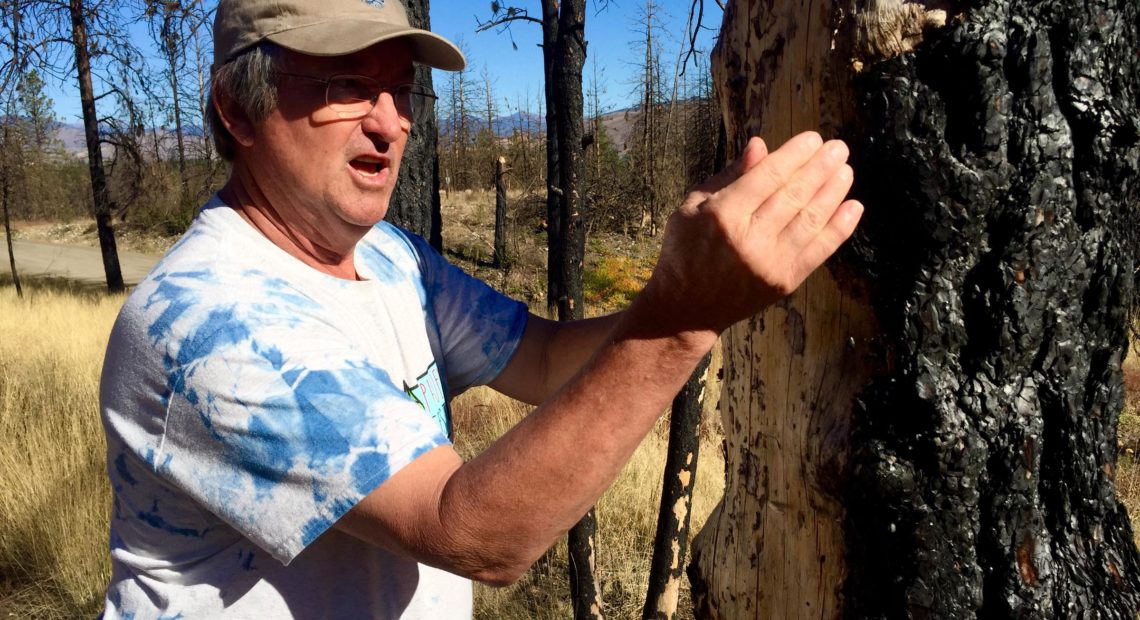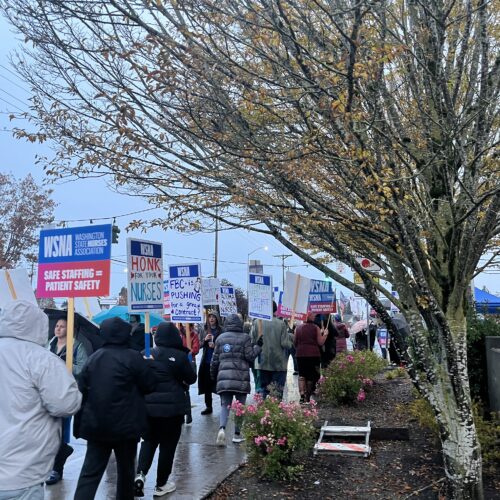
Leaving Behind Burned Trees For Bird Habitat




Listen
Two summers ago, a firestorm swept through Ken Bevis’ land outside Winthrop. It scarred hillsides, destroyed homes and outbuildings. Bevis turned to his folk music to help cope.
“They set their hose, they made a stand, poured water on the flames. Stomped embers and kept our house from burning to the ground. Ooooh, they fought that firestorm,” he wrote in “Firestorm.”
As Bevis looks out over his property, once full of shrubs and tall, thick ponderosa pine trees, now he sees dead, blackened trunks poking out of the hill.
“We had a significant transformation of the habitat,” Bevis said.
But where many would mourn the loss of bird habitat, Bevis — a wildlife biologist with the state Department of Natural Resources — knows better. To him, these dead trees are beautiful. To the birds in his backyard, they are now home.
“There’s life in dead trees,” Bevis said. “There’s no other single habitat feature that has that much of an effect on forest biodiversity.”
Woodpeckers ate the beetles that wedged beneath the charcoal-like bark. Other birds that need nests — like swallows or bluebirds — can claim those abandoned woodpecker holes. The spindly limbs make for fantastic perches.
Through his entire career, Bevis has advocated leaving dead trees alone. These still-standing remains are also known as snags. He said it’s ironic that he now has his own snag patch: somewhere around 140 dead ponderosa pines on his 15 acre lot.
“As wildlife biologist it’s just pretty interesting to have a personal laboratory here to study snags,” Bevis said. “I’m really curious about how long these will last because we know exactly the day they died.”
The change in habitat has brought new birds to his land. Among them: woodpeckers. So many woodpeckers that he wrote a song, “King of the Woods.”
“I’m a crazy red hammer. I make cavities — homes for you, homes for me. Hey, hey! I’m the king of the woods,” he sang.
Everything he and his wife have done since the fire has been to enhance the changes in the habitat for birds.
They’ve left the dead trees standing, planted hundreds of berry bushes, ponderosa pine and aspen trees. They’ve let the native bunch grasses grow back. They’ve even rebuilt several nest boxes and hung them in some of the snags and all around their house.
“The nest box provides a cavity before the bird might have provided it,” Bevis said. “And so it’s an enhancement, an add-on.”
He has upwards of 20 nest boxes scattered around his property.
A few miles away in Twisp, Patrick Hannigan builds nest boxes to help cavity-nesting birds. The boxes have to be designed specifically with each species in mind. Dozens of boxes line his workshop.
Hannigan said nest boxes can increase bird populations. It’s something he and his six-year-old daughter have watched happen in their backyard.
“We get a lot of joy out of watching the annual cycle of the birds returning and nest building and feeding their young and the fledging, where you have clouds of really small birds, barely out of the nest box, flying around. It brings a lot of life and joy to a place,” Hannigan said.
At his home, Ken Bevis opens up a nest box that hangs along his deck. It’s home to his favorite bird: a tree swallow.
“Let’s look in this one,” Bevis said. “It’s full of grass and feathers.”
He thinks multiple generations of tree swallows may be returning to his nest boxes every year.
“Wildlife is a response to whatever conditions you give it. We think we manage wildlife. We don’t manage wildlife. We manage habitat,” Bevis said.
That goes for all habitat — even landscapes ravaged by wildfire.
This story is produced by NWPR in collaboration with BirdNote. It’s part of a series made possible by a grant from the Icicle Fund.
Related Stories:

Nursing union at St. Joseph Medical Center in Tacoma reaches tentative agreement
Nurses at Tacoma’s St. Joseph Medical Center could soon have a new collective bargaining agreement with higher wages, improved safety measures in the hospital and some staffing mandates.
The bargaining team for the nurses reached a tentative agreement with the hospital after months of bargaining. This week, all employees at the hospital represented by the Washington State Nurses Association have a chance to vote on the contract.

How Whitman College is reckoning with its past
Whitman College’s dining hall will now serve first foods, such as elk, trout and root vegetables, on a monthly basis. (Credit: Susan Shain / NWPB) Listen (Runtime 4:00) Read On

As Northwest snowpack grows, ski resorts open early
A drone photo shows White Pass Ski Area in Naches, Washington, on Dec. 1, 2024. (Credit: Andy Mahre / White Pass Ski Area) Listen (Runtime 1:00) Read Fresh white powder












